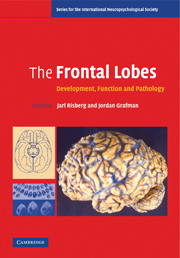Book contents
- Frontmatter
- Contents
- Contributors
- From the series editor
- Introduction
- 1 Evolutionary aspects on the frontal lobes
- 2 Organization of the principal pathways of prefrontal lateral, medial, and orbitofrontal cortices in primates and implications for their collaborative interaction in executive functions
- 3 Human prefrontal cortex: processes and representations
- 4 A microcircuit model of prefrontal functions: ying and yang of reverberatory neurodynamics in cognition
- 5 Prefrontal cortex: typical and atypical development
- 6 Case studies of focal prefrontal lesions in man
- 7 Left prefrontal function and semantic organization during encoding and retrieval in healthy and psychiatric populations
- 8 Clinical symptoms and neuropathology in organic dementing disorders affecting the frontal lobes
- Index
- Plate section
- References
6 - Case studies of focal prefrontal lesions in man
Published online by Cambridge University Press: 11 September 2009
- Frontmatter
- Contents
- Contributors
- From the series editor
- Introduction
- 1 Evolutionary aspects on the frontal lobes
- 2 Organization of the principal pathways of prefrontal lateral, medial, and orbitofrontal cortices in primates and implications for their collaborative interaction in executive functions
- 3 Human prefrontal cortex: processes and representations
- 4 A microcircuit model of prefrontal functions: ying and yang of reverberatory neurodynamics in cognition
- 5 Prefrontal cortex: typical and atypical development
- 6 Case studies of focal prefrontal lesions in man
- 7 Left prefrontal function and semantic organization during encoding and retrieval in healthy and psychiatric populations
- 8 Clinical symptoms and neuropathology in organic dementing disorders affecting the frontal lobes
- Index
- Plate section
- References
Summary
Introduction
Against the nineteenth century backdrop of the tension between Franz Joseph Gall and Johann Spurzheim's phrenology versus Marie-Jean-Pierre Flourens' equipotentiality, Paul Broca and subsequently Carl Wernicke demonstrated cortical localization of expressive and receptive language functions and their descriptions were soon embraced by the larger medical and scientific community. As additional evidence of hemispheric specialization, John Hughlings Jackson described difficulty with “memory for persons, objects, and places” associated with posterior right hemisphere lesions which led him to introduce the term “imperception” (Finger, 1994). Interest in the frontal lobe was largely restricted to language characteristics associated with lesions of Broca's area as contrasted against those associated with more posterior lesions involving Wernicke's area.
Despite the advances of understanding brain function in the second half of the nineteenth century, the tension between the localizationist versus antilocalizationist camps continued to be present. Current interest in the frontal lobe extends far beyond expressive speech, and involves its role in executive functioning, perseveration, judgment, attention, emotional behavior, and motor programming and regulation, with regional specialization within the frontal system increasingly appreciated for unique contributions to complex human behavior. Thus, localization and antilocalization approaches are able to coexist within a functional system framework. In the present chapter, we will present important cases demonstrating the behavioral impairments associated with prefrontal lobe lesions that have greatly contributed to our understanding of neuropsychological functions of these regions.
- Type
- Chapter
- Information
- The Frontal LobesDevelopment, Function and Pathology, pp. 163 - 177Publisher: Cambridge University PressPrint publication year: 2006

